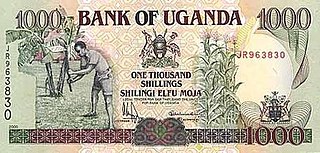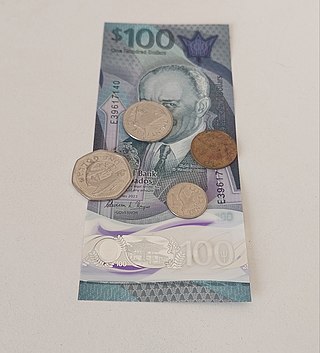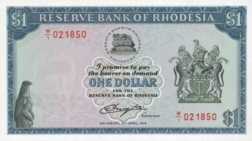The Kwacha is the currency of Zambia. It is subdivided into 100 Ngwee.

The pula is the currency of Botswana. It has the ISO 4217 code BWP and is subdivided into 100 thebe. Pula literally means "rain" in Setswana, because rain is very scarce in Botswana—home to much of the Kalahari Desert—and therefore valuable and a blessing. The word also serves as the national motto of the country.
The leone is the currency of Sierra Leone. It is subdivided into 100 cents. As of 1 July 2022, the ISO 4217 code is SLE due to a redenomination of the old leone (SLL) at a rate of SLL 1000 to SLE 1. The leone is abbreviated as Le placed before the amount.

The shilling is the currency of Uganda. Officially divided into cents until 2013, due to substantial inflation the shilling now has no subdivision.

The shilling is the currency of Tanzania. It is subdivided into 100 cents . The Tanzanian shilling replaced the East African shilling on 14 June 1966 at par.
The Cayman Islands Dollar is the currency of the Cayman Islands. It is abbreviated with the dollar sign $, or alternatively CI$ to distinguish it from other dollar-denominated currencies. It is subdivided into 100 cents.

The Fijian dollar has been the currency of Fiji since 1969 and was also the currency between 1867 and 1873. It is normally abbreviated with the dollar sign $, or alternatively FJ$ to distinguish it from other dollar-denominated currencies. It is divided into 100 cents.

The Guyanese dollar has been the unit of account in Guyana since 29 January 1839. Originally it was intended as a transitional unit to facilitate the changeover from the Dutch guilder system of currency to the British pound sterling system. The Spanish dollar was already prevalent throughout the West Indies in general, and from 1839, the Spanish dollar unit operated in British Guiana in conjunction with British sterling coins at a standard conversion rate of one dollar for every four shillings and twopence. In 1951 the British sterling coinage was replaced with a new decimal coinage which was simultaneously introduced through all the British territories in the Eastern Caribbean. When sterling began to depreciate in the early 1970s, a switch to a US dollar peg became increasingly attractive as an anti-inflationary measure and the Eastern Caribbean Currency Authority made the switch in October 1975. The Guyanese dollar is normally abbreviated with the dollar sign $, or alternatively G$ to distinguish it from other dollar-denominated currencies.

The dollar has been the currency of Liberia since 1943. It was also the country's currency between 1847 and 1907. It is normally abbreviated with the sign $, or alternatively L$ or LD$ to distinguish it from other dollar-denominated currencies. It is divided into 100 cents.

The dollar has been the currency of Barbados since 1935. Globally its currency has the ISO 4217 code BBD, however, unofficially in Barbados the International vehicle registration code BDS is also commonly used, a currency code that is otherwise reserved for Bangladesh outside Barbados. As such the present dollar has the ISO 4217 code BBD. The Barbadian dollar is divided into 100 cents.
The Saint Helenapound is the currency of the Atlantic islands of Saint Helena and Ascension, which are constituent parts of the British Overseas Territory of Saint Helena, Ascension and Tristan da Cunha. It is fixed at parity with sterling, and so both currencies are commonly accepted and circulated within Saint Helena. It is subdivided into 100 pence.
The Solomon Islands dollar is the currency of Solomon Islands since 1977. Its symbol is $, with SI$ used to differentiate it from other currencies also using the dollar sign. It is subdivided into 100 cents.

The East African shilling was the sterling unit of account in British-controlled areas of East Africa from 1921 until 1969. It was issued by the East African Currency Board. It is also the proposed name for a common currency that the East African Community plans to introduce.

The pound was the currency of Southern Rhodesia from 1964 to 1965 and Rhodesia from 1965 until 1970. It was subdivided into 20 shillings, each of 12 pence.
The coins of the Rhodesian dollar were part of the physical form of Rhodesia's historical currency, the Rhodesian dollar.
The pound was the currency of the Gambia between 1965 and 1971. Gambia used the British West African pound until it issued its own currency on October 5, 1964. In 1971, the dalasi replaced the pound at a rate of £1 = D5. 1 pound was made up of 20 shillings, each shilling consisting of 12 pence.

The pound was the currency of the Federation of Rhodesia and Nyasaland. It was subdivided into 20 shillings, each of 12 pence.

The pound was the currency of Southern Rhodesia. It also circulated in Northern Rhodesia and Nyasaland. The pound was subdivided into 20 shillings, each of 12 pence.

The dollar was the currency of the Dominion of Newfoundland, from 1865 until 1949, when Newfoundland became a province of Canada. It was subdivided into 100 cents.
The coins of the Rhodesian pound were part of the currency of Southern Rhodesia, which changed its name to Rhodesia, following the break-up of the Federation of Rhodesia and Nyasaland, when the Rhodesian pound replaced the Rhodesia and Nyasaland pound, which had replaced the Southern Rhodesian pound.




























